Exploring Wall-Mounted Curtain Rods for Design Impact
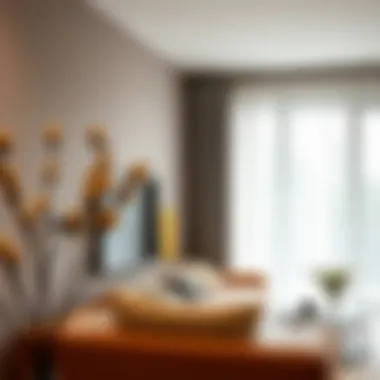
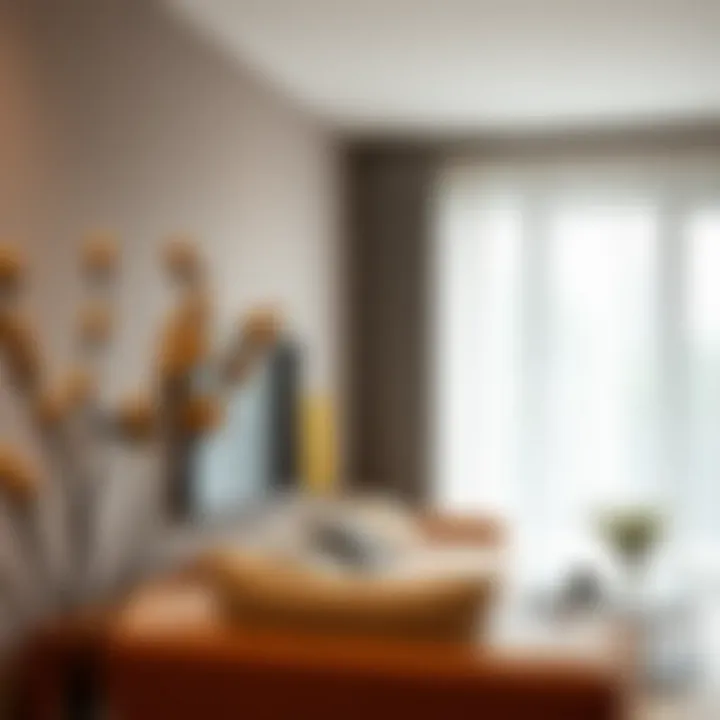
Intro
When it comes to interior design, the devil is in the details, and one such detail that often flies under the radar is the curtain rod. Specifically, curtain rods that extend from the wall have gained momentum in recent years. These rods do more than just hold up your drapes; they can profoundly alter the perception of space and light in a room. Their functionality goes hand in hand with aesthetic appeal, offering endless possibilities for homeowners, designers, and DIY enthusiasts.
Curtain rods that project outward allow you to hang fabric that lessens the emphasis on an enclosed area while also creating a feeling of fullness and warmth. Choosing the right rod can curate a specific ambiance, turning an ordinary room into a retreat.
This article aims to provide a comprehensive guide on these versatile fixtures. We will examine factors such as current furniture design trends, aesthetic options, and installation techniques, all while bearing in mind how they can transform your space. By the end, you’ll have a well-rounded understanding of curtain rods that extend from the wall, along with practical tips to make an informed purchase and installation. Let's get started!
Furniture Design Trends
Current Styles and Aesthetics
As interior design continues to evolve, so do the styles of curtain rods. Gone are the days of similarly shaped and dull rods. Today, it's all about making a statement.
Industrial designs are a popular choice, featuring raw metals and minimalistic looks that give an urban, modern feel. These rods can be paired with lightweight, sheer fabrics that float effortlessly, embodying both functionality and style.
On the softer side, bohemian aesthetics introduce wooden rods enhanced with artisanal details, making them perfect for rustic or eclectic spaces. Homeowners often find that the softness of drapes paired with natural wood creates an inviting atmosphere.
Mid-century modern styles also remain timeless. With their clean lines and vibrant colors, these rods offer a touch of nostalgia without being overwhelming. They work wonders in spaces that celebrate simplicity and elegance without much fuss.
Overall, selecting the right style depends on your room's theme and the atmosphere you wish to create. Curtain rods today aren't just utilitarian; they are integral to the overall aesthetics of a room.
Color Palettes and Materials
Colors and materials play a significant role in how curtain rods complement a room’s design. The choice isn’t limited to the classic metallic finishes; instead, you're presented with an array of options.
Brushed brass or copper can impart a warm glow and work well in both traditional and transitional settings.
On the other hand, you might find matte black or gunmetal gray increasingly favored for a contemporary look. These choices often create a striking contrast against lighter drapery, drawing the eye toward the window rather than allowing it to fade into the background.
Natural materials certainly hold their own as well; wood rods come in various stains or even painted to fit within a color scheme. They exude warmth and can harmonize beautifully with earthy tones present in many modern-day interiors.
When selecting rod colors and materials, think practically about the surrounding decor, but express a little creativity too! The best option sparks the room into life, captivating attention without overwhelming other elements.
"Curtain rods are not just an accessory; they are a design feature that can make or break the look of a room."
Buying Guides
Essential Considerations When Purchasing
Buying a curtain rod involves more than just aesthetic choices. Start by considering how much space you have and the type of curtains you plan to use. The following are critical factors:
- Length and Projection: Choose a rod length that extends beyond the window width to allow natural light to filter in when the curtains are open. The projection should also accommodate the curtain fabric so it doesn't crowd the window.
- Weight Capacity: You'll want a rod strong enough to hold the drapery without bowing or bending. Heavier materials require sturdier rods.
- Mounting Options: Some rods can be wall-mounted, while others come with brackets for ceiling installation. Depending on your ceiling height and decor style, the right option is essential.
Top Recommendations for Different Budgets
For those on a tighter budget, the IKEA RÄCKA series offers a great blend of affordability and style, easily adaptable to various room themes. Moving up a notch, the West Elm, known for quality designs, provides excellent mid-range options.
For high-end purchases, consider the RH (Restoration Hardware) rods. Elegant and timeless, their rods can add a sense of luxury to any room.
When curating your shopping list, keep your overall budget in mind. Whether it’s a high-end purchase or a budget-friendly find, the right curtain rod can set the stage for everything that follows n.
This article thus paints a detailed picture of curtain rods that extend from the wall, highlighting their potential in transforming your living space.
Foreword to Curtain Rods
When it comes to interior design, curtains play a pivotal role. They serve more than just a functional purpose of covering windows; they are the artwork that transforms spaces. This is where curtain rods come into play, particularly those that extend from the wall, aptly designed to enhance both the aesthetics and functionality of our living areas.
Having the right curtain rod can drastically change the feel of a room. It's about finding that perfect balance between style and usability. Any homeowner or designer should recognize that these rods not only support the curtains but also contribute to the overall look and mood of the room. An understanding of their design and function could make a world of difference in achieving a polished and cohesive decor.
The reasons for selecting the right curtain rod extend beyond mere aesthetics. They can prove instrumental in optimizing natural light and enhancing privacy. Likewise, they play a significant role in the perceived dimensions of a space. An extended curtain rod, for instance, can create an illusion of larger windows or ceilings, which can be particularly beneficial in smaller rooms.
In this article, we’ll explore the multifaceted world of curtain rods. From their functions to their design significance, understanding these elements can lead to better choices for every type of living space. Let's dive into their essential workings and the importance of their design.
Understanding Curtain Rod Functions
Curtain rods might seem straightforward at first glance, but their functions are diverse and nuanced. At its core, a curtain rod provides the necessary support for hanging curtains. However, different rods come with various capabilities. For example, some rods allow curtains to glide smoothly, while others might be more about visual appeal. Not all curtain rods are created equal, and knowing the differences can help you make informed decisions.
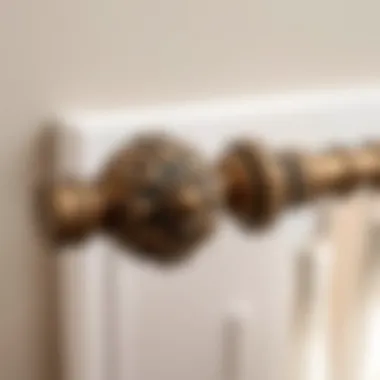
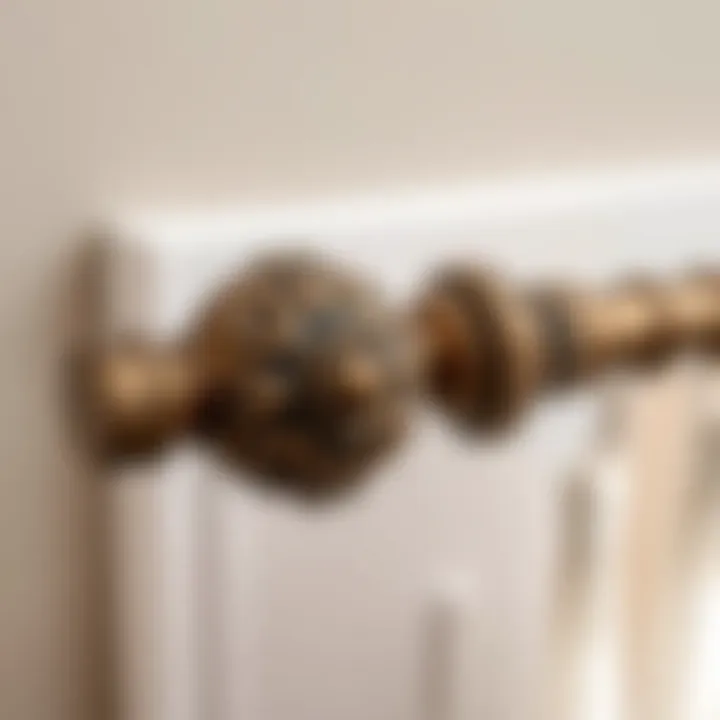
Consider these key functions:
- Support: Of course, their primary function is to hold curtains. The materials and sturdiness of the rod play a role in how well it can support the weight of the fabric.
- Accessibility: Rods with rings or clips allow for easy adjustment and movement of the curtains. This is crucial for those who regularly open and close their curtains.
- Aesthetic Appeal: A well-chosen curtain rod can elevate the entire room. Options such as decorative finials can become conversation starters and add uniqueness.
Importance of Design in Curtain Rods
When it comes to curtain rods, design isn’t just about looks. It encompasses different styles, materials, and functionality that all weave together to create a coherent visual statement. An aesthetically pleasing rod adds a finishing touch that can complement the decorative themes of any room.
- Style Variations: Whether one opts for sleek, modern lines or intricately designed traditional details, the design reflects personal taste. Choosing the right design can dramatically impact how the room feels.
- Color and Finish: The color of a curtain rod needs to harmonize with the curtains themselves and the surrounding decor. For instance, a matte black rod can offer a striking contrast in a bright, airy space and anchor the room’s overall look.
- Material Considerations: Wood, metal, or even plastic can dictate the overall impression of the space. A sturdy metal rod may provide a more industrial vibe, while a wooden rod could add warmth.
"Choosing the right curtain rod serves as a canvas for window transformation, enhancing the beauty of the drapes and the room itself."
Curtain Rods: An Overview
When it comes to decorating a room, the right curtain rod can make a world of difference. Curtain rods do more than just hold up your curtains; they set the stage for the entire window treatment. In understanding curtain rods, one must consider their functionality and how they fit into the broader context of your home’s design. This section digs into the various types and materials for curtain rods, ensuring a well-rounded decision for your space.
Types of Curtain Rods
Single Rod
A single rod is the most straightforward option for hanging curtains. Typically made of materials like metal or wood, it's a simple straight piece extending horizontally from the wall. Its primary benefit is versatility. It’s ideal for lightweight curtains, such as sheer panels, and can easily complement any decor style due to its minimalist design. Furthermore, the ease of installation makes it a popular choice for many homeowners. However, if you're looking to layer fabrics for added depth, it might fall short in that department. A single rod may not offer the same visual interest as more complex systems. Still, for budget-conscious folks or those new to curtain installation, this option is approachable and manageable.
Double Rod
Double rods are two distinct rods fixed parallel to each other, allowing for the layering of curtains. This design is particularly advantageous for creating a sense of depth, especially in rooms that can benefit from light control or privacy. For instance, heavier curtains can be drawn at night, while sheers can remain during the day, maintaining brightness. The double rods not only enhance layering but also showcase the different textures of fabric beautifully. That said, the installation is somewhat more complicated compared to a single rod, requiring careful measuring and sometimes additional hardware. But for those keen on visual appeal, the investment in time and effort pays off.
Traverse Rods
Traverse rods offer unique functionality, particularly for those who value convenience. Designed for curtains that slide open and closed with ease, these rods are perfect for wider windows and large curtain expanses. They come with gliders that allow curtains to move smoothly side to side. This type of rod works well with heavier fabric as well, providing necessary support. While they can be more complex to install and might involve a slightly higher price point, the effortless functionality they bring can be worth it. Homeowners seeking a blend of style and practicality often find traverse rods beneficial.
Material Choices
Wood
Wooden curtain rods can infuse warmth and character into your space. The key characteristic of wood is its ability to meld with various themes, from rustic farmhouses to elegant traditional homes. They come in a variety of finishes, from distressed to polished. The unique feature of wood lies in its natural grain and texture, adding an organic element that metal or plastic can’t replicate. However, wood can be heavier and may require sturdier brackets for installation. Additionally, it may not hold up in humid environments as well as other materials, leading to potential issues like warping over time.
Metal
Metal rods, often finished in sleek iron, brass, or chrome, are perfect when one is after a modern touch. Their durability is one of the standout traits. They can support heavier drapes without bending or breaking. The clean lines and reflective surfaces of metal rods often enhance a contemporary aesthetic. However, not all metal rods are created equal; some may show fingerprints or scratches more readily than others. Choosing a quality finish can help mitigate this. Plus, the range of designs available ensures that there's likely a metal rod to suit your style.
Plastic
Plastic curtain rods may not be as glamorous as wood or metal, but they have a special place in the market. They are lightweight, making them a breeze to install, and they come in quite a few colors and styles. Plastic rods tend to be more budget-friendly, which is important for those styling rental spaces or temporary homes. However, the downside is their often limited strength, which can restrict choices in heavy curtain fabrics. Choosing the right plastic rod wisely, particularly one designed for weighty drapes, ensures better performance.
"Choosing the right curtain rod goes beyond functionality; it's about finding a piece that enhances your entire design framework."
In summary, whether choosing a single, double, or traverse rod—or a wooden, metal, or plastic one—each choice interacts with your room’s design language in a unique way. Weighing the pros and cons of each type and material helps to narrow down the best option for your living space.
Features of Wall-Extending Curtain Rods
The focus on wall-extending curtain rods brings to light several vital aspects regarding their installation and functionality. They’re not just about the fabric hanging in your window, but more about how they influence the ambiance and functionality of a space. By extending out from the wall, these rods help achieve a certain depth in your interior decor. Understanding these features is key for homeowners and designers who aim to strike the perfect balance between form and function.
Projection from the Wall
The projection of curtain rods from the wall is essentially how far they extend outward. This feature can be a game changer when it comes to light control and the overall perception of space. A curtain rod that projects more can give more room for drapes to be drawn back, allowing natural light to flow freely into the room. Therefore, homeowners aiming for well-lit interiors should prioritize this consideration.
An optimal projection allows curtains to hang beautifully without blocking window space when opened. The rod's placement can also influence how tall or spacious a room feels. Some prefer a more discreet projection, while others may want curtains to really stand out against the wall.
Style Variations
Selecting wall-extending curtain rods comes with various styles to fit the desired theme of your space. From contemporary sleek designs to traditional classic looks, this variety is essential for personal expression in interior design.
Contemporary
The contemporary style often features clean lines and minimalistic designs that can easily blend in with modern decor. This type is characterized by its sleek finishes, often in metals like stainless steel or brushed nickel, which can give an airy feel to rooms.
Contemporary curtain rods also frequently come with innovative mounting options that allow for easy adjustments. They are a popular choice because they do not overpower a space; instead, they complement it. One downside, though, is that they may not fit well in more traditional or ornate settings.
Traditional
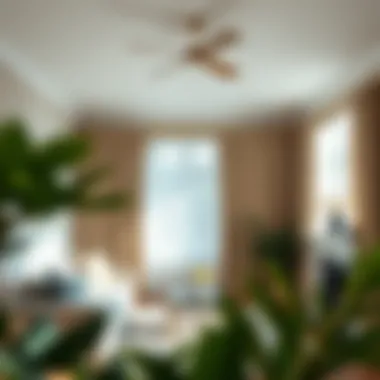

In contrast, traditional curtain rods often reflect timeless designs with intricate detailing. These rods may be crafted from wood or painted metal in rich, vintage tones. The key characteristic of this style is its warmth and elegance, which complements classic architecture and decor.
Traditional rods often add drama to a room, particularly when adorned with decorative finials. However, homeowners must consider that the richness of these rods may look out of place in modern settings or minimal spaces, creating a disconnect in design elements.
Industrial
The industrial style has become increasingly popular, marked by rugged materials and bold aesthetics. These rod designs often use blackened steel or wrought iron, lending an edge to spaces that embrace a more raw, urban vibe. They typically feature thick, chunky shapes that make a statement in any room.
The appeal here lies in their uniqueness. An industrial rod can serve as a focal point, a conversation starter, or a way to add contrast in softer spaces. On the flip side, its strong aesthetic can sometimes clash with more classic or delicate decor, limiting versatility.
Practical Advantages
Beyond the aesthetics, wall-extending curtain rods come with practical advantages that enhance their overall value.
Enhanced Light Control
One of the primary benefits of wall-extending rods is the enhanced light control they facilitate. When curtains are drawn back on rods that project well, the amount of sunlight entering a room can significantly increase. This plays a critical role in setting the mood of a space. It also helps in preventing unwanted drafts from windows, leading to a more comfortable home environment.
Improved Room Aesthetics
Another notable advantage is the boost in room aesthetics. Rods that extend allow for curtains to hang perfectly and create soft lines in the room. This smooth, elegant look can make a room feel more finished and visually appealing. Homeowners can also choose contrasting rods and fabric colors for a striking effect, enhancing the overall design.
Better Space Utilization
Finally, better space utilization is a tremendous value add. A well-projected curtain rod can, in essence, open up space. Curtains that push back adequately can create a more expansive feeling in smaller rooms, making them visually larger and more welcoming. This feature provides a substantial benefit especially in urban settings where space is often at a premium.
In short, the features of wall-extending curtain rods are a combination of aesthetics and practicality, merging style with usability in an effective way.
Selecting the Right Curtain Rod
Selecting the right curtain rod isn’t merely a task; it’s a pivotal decision that shapes the ambiance of your living space. Curtain rods that extend from the wall play a significant role, influencing both practicality and aesthetics. Choosing wisely ensures that your curtains complement not just the style of the room, but also their intended functionality.
Considerations for Size and Length
When it comes to size and length, there are a few nuggets of wisdom to keep in mind. The first order of business is measuring not just the width of your window, but also the height and how far you want those curtains to reach. A general rule of thumb is to add around 6 to 12 inches on either side of the window frame. This additional length allows the curtains to stack back, giving you an illusion of a larger window and more natural light when they’re open.
- Height Matters: Hanging the curtain rod higher than the window frame can also enhance the perception of height in a room. If you have a low ceiling, you might think about installing the rod closer to the ceiling.
- Curtain Length: Depending on the look you’re after, consider if you want the curtains to just kiss the floor, or if you'd prefer a puddling effect for a more romantic feel.
"The right length and size make all the difference in achieving that polished look in your room."
Choosing the Right Finish
The finish of your curtain rod isn’t just a cosmetic decision; it contributes to the overall aesthetic harmony of the room. The finish can drastically alter the look and feel of your window treatment. Whether you opt for a sleek metal, a warm wood finish, or even a painted plastic, here are some considerations to ponder:
- Metal Finishes: Stainless steel or matte black rods can provide a modern appearance, fitting well in contemporary or industrial decor. They also tend to be relatively robust.
- Wood Finishes: On the other hand, wooden curtain rods often evoke warmth and coziness, lending themselves to rustic or traditional spaces.
- Colored Finishes: A pop of color can turn a simple rod into a statement piece. If your room is filled with neutral tones, a vibrant painted rod can work wonders to brighten up the space.
Ultimately, aligning the finish with the existing elements in the room can elevate your design choices. Whether your look is more understated or bold, the finish you select will play a role in not just the look of the curtains but also how they resonate with the design theme of the overall space.
Installation Considerations
When it comes to curtain rods that extend from the wall, understanding the installation process is key. Getting this part right can mean the difference between a flawless finish and a lingering feeling that something is off in the room. Whether you're a homeowner looking to add some personality to your space or a DIY enthusiast excited about a new project, paying attention to installation details ensures that your curtain rods will not only look good but also function effectively. Here’s a closer look at the aspects you should consider before you dive in.
Tools Required for Installation
Before you even think about hanging your curtain rods, gather the necessary tools to avoid those pesky last-minute trips to the hardware store. Here’s what you typically need:
- Drill: A good power drill is essential for making holes.
- Screwdriver: Both Phillips and flathead might come in handy.
- Level: Ensures that your rods are straight, preventing any crooked appearance.
- Measuring Tape: Accurate measurements can save you a whole lot of head-scratching later.
- Stud Finder: Useful for locating the best places to attach your curtain brackets securely.
- Pencil or Marker: For making small markup lines where the brackets will be attached.
- Safety Glasses: Protect your eyes while drilling.
Step-by-Step Installation Guide
Installing curtain rods may seem daunting at first, but it can be tackled in a systematic way. Here’s a straightforward guide:
- Choose Your Location: Decide where you want your curtain rods to go. Ideally, you want them high enough to give the room the appearance of height.
- Mark the Wall: Use a measuring tape to find the appropriate height and width, then mark the spots for your brackets gently with a pencil.
- Find the Studs: Use your stud finder to identify whether you need to insert screws directly into the studs for stability. If not, hollow wall anchors may be necessary.
- Drill Holes: Carefully drill holes into the marked spots. Remember to keep your drill level for precise placements.
- Attach the Brackets: Secure the brackets using the screws supplied. Ensure they are tight and level.
- Insert the Rod: Slide your curtain rod through the brackets, making sure it’s balanced.
- Hang Your Curtains: Lastly, add the curtains and adjust them. Step back and admire your work!
Common Installation Mistakes
Even seasoned DIYers can slip up. Here are a few common pitfalls to watch out for when installing curtain rods:
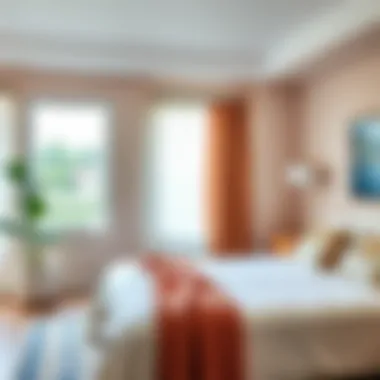
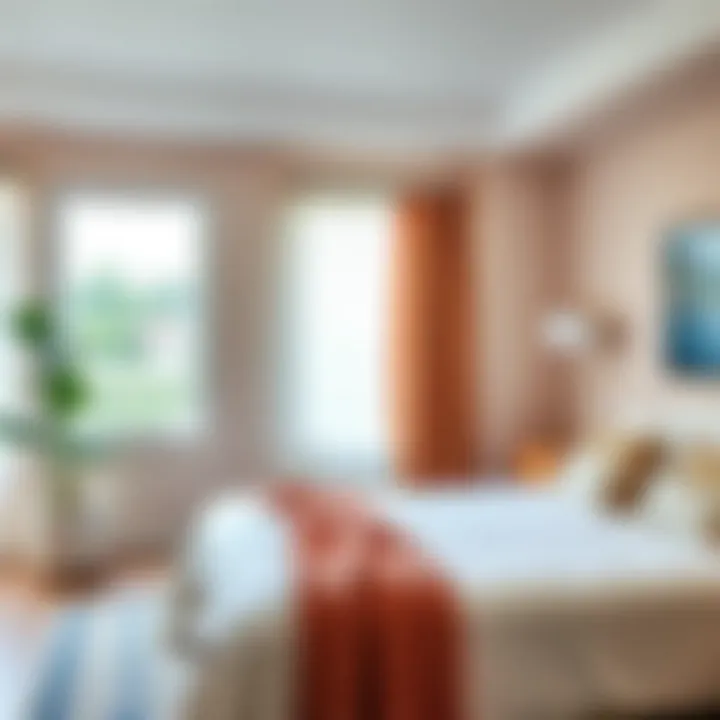
- Ignoring Measurements: Skipping the measuring step can lead to uneven rods. Taking care to measure twice can save time.
- Overlooking the Weight of the Curtains: Some materials are heavier than others, and if you don’t factor this in, the rods might sag or even fall.
- Not Leveling the Brackets: This can result in a less polished look. Use a level to keep everything aligned.
- Forgetting to Secure Brackets Properly: Loose brackets can come crashing down, breaking the rod and possibly damaging your wall. Make sure they are tight.
"Good installation is the cornerstone of a successful curtain rod journey. It may take a little time, but it pays off with aesthetic and functional returns that make your rooms shine."
In closing, understanding these installation considerations helps in transforming a simple task into an art form. The key is preparation, so take the time to equip yourself with the right tools and knowledge. The end result will be worth every minute spent prepping those walls.
Curtain Rods in Interior Design
Curtain rods not only serve a functional purpose but also play a pivotal role in enhancing the overall aesthetics of a space. When one considers interior design, it's easy to overlook elements like curtain rods, yet their impact can be as significant as that of furniture choices or wall colors. The right curtain rod can complement a room's design, add character, and create a cohesive look.
Influencing Room Perception
The way a space feels is often influenced by its visual elements, and curtain rods are no exception. Wall-extending curtain rods, in particular, can create the illusion of larger windows. This is achieved by allowing the curtains to hang beyond the edges of the window frame, which can trick the eye into thinking the window is wider and more spacious than it actually is. In smaller rooms, maximizing perceived space can make all the difference in comfort and functionality.
Here are a few ways that curtain rods can influence the perception of a room:
- Heightened Ceilings: By placing curtain rods close to the ceiling, it emphasizes vertical lines and can give the illusion of taller walls, making the room feel airier.
- Softening Hard Edges: Curtains introduce softness in a room filled with straight lines. A well-chosen rod can contribute to this effect by alternating between sharp, sleek designs and more rounded, flowing ones.
- Flow and Movement: The way curtains drape and move can enhance the dynamism of a space. For instance, sheer curtains paired with a robust metal rod can create a contrast that catches the eye and invites movement into the design.
Complementing Existing écor
Curtain rods can be cherry on top of a well-designed cake. The styles and materials you choose should resonate with the existing décor to achieve harmony in the design scheme. For instance, if your home leans towards a rustic aesthetic, opting for wooden rods with wrought iron brackets can seamlessly blend in with the surroundings.
Moreover, choices in color and texture are crucial. A bold, antique gold rod can stand out beautifully against a neutral backdrop, while a chic, matte black can maintain a minimalist vibe in a modern setting.
When selecting curtain rods that complement your décor, consider these aspects:
- Finish: Choose finishes that mirror or contrast with existing fixtures in a room, like doorknobs or light fixtures.
- Material Harmony: Wood, metal, or plastic should resonate with furniture styles; an industrial space may benefit from exposed metal whereas a cozy room may call for warmer wood.
- Emphasizing Patterns: If your curtains have a vibrant pattern, a simple rod can allow them to shine without overwhelming the space.
"The right curtain rod is like a well-fitted frame; without it, the picture might be worthwhile, but with it, the entire scene comes together in a harmonious way."
Maintenance and Care
Maintaining curtain rods, especially those that extend from the wall, is a task often overlooked, yet it plays a crucial role in ensuring both functionality and aesthetic appeal. Regular maintenance not only extends the life of the rods but also reinforces their contribution to your home’s decor. When you invest time in caring for these fixtures, you preserve their beauty and ensure that they continue to perform as intended.
Cleaning Techniques for Different Materials
Different materials used in curtain rods require different cleaning techniques. Here’s a breakdown of how to clean the most common materials:
- Wood Rods: Wood adds warmth to a room but can collect dust and grime. Wiping these rods with a damp cloth followed by a dry one helps keep them clean. Occasionally, a wood polish can enhance their luster and shield against moisture.
- Metal Rods: Metal rods, often made from materials like steel or aluminum, are relatively low-maintenance. Use a soft rag with soap and water for cleaning, ensuring to avoid harsh chemicals that could erode the finish. For shiny metals, a little metal polish can catch the right shine.
- Plastic Rods: Plastic options are generally light and affordable but can attract dust. A soft damp cloth usually does the trick, but if there's a stubborn stain, a mild detergent might be necessary. Just ensure they are thoroughly dried afterward to prevent warping.
In all cases, it's beneficial to clean these rods at least once every season. Missing this routine can lead to buildup that becomes difficult to remove when neglected.
Inspecting for Damage
Inspecting curtain rods for damage is just as vital as cleaning them. Wear and tear can happen without notice, often leading to bigger problems down the road if not addressed quickly. Here's what to keep an eye on:
- Rust on Metal Rods: If you spot any rusting, tackle it immediately. Rust can weaken the structure and lead to failure. Use fine steel wool to remove rust, then apply a protective coat of paint.
- Cracks in Wood Rods: Cracks might arise due to fluctuations in humidity. If cracks develop, consider applying a wood filler or simply replacing the rod if the damage is extensive.
- Warping of Plastic Rods: Plastic rods can warp if subjected to extreme heat. If you notice bending, it may be time to replace them rather than risk a collapse under a curtain’s weight.
Regular inspection should be part of your routine—perhaps during cleaning. Just a quick three-minute glance can save you from future headaches.
"An ounce of prevention is worth a pound of cure"—this saying rings particularly true when it comes to maintenance and care of your curtain rods. Keeping up with these tasks ensures they not only complement your design but function properly for years to come.
Ending
The conclusion is quite vital in wrapping up discussions on curtain rods that extend from the wall. This topic not only highlights functional aspects but also delves into how these rods can significantly influence room aesthetics. As homeowners, designers, and DIY enthusiasts explore the various styles and practicalities of installation, they will find that choosing the right curtain rods can radically transform a living space.
The essence of this article rests on a few key elements. Firstly, the versatility of projection allows for better light control, which is a fundamental factor in setting the mood of a room. Additionally, different styles – whether contemporary or traditional – offer opportunities to express personal taste, enhancing overall decor. It’s important to consider the balance between functionality and design, ensuring that the selected curtain rods not only serve their purpose but also uplift the room’s visual appeal.
Moreover, the installation techniques discussed provide practical know-how that anyone can follow, mitigating common mistakes. This instructional guidance emphasizes that employing the right tools—and being aware of potential pitfalls—can ease the installation process.
Ultimately, the thoughtful selection of curtain rods contributes to space utilization. Choosing rods that extend appropriately creates a sense of depth and openness, which is paramount in smaller environments. Therefore, an understanding of these aspects can lead to more informed and satisfying choices.
"Choosing the right curtain rod is key. It’s not just about hanging curtains; it’s about how each element in a room interacts with others."
Recap of Key Points
To summarize, key highlights from this exploration include:
- Functionality: Curtain rods serve practical purposes, such as controlling light and privacy.
- Aesthetic Variety: The design choices, ranging from wood to metal, play a big role in decor and style.
- Installation: A step-by-step guide aids in ensuring correct installation, emphasizing the right tools and avoiding common mistakes.
- Space Dynamics: Well-chosen rods can make a room feel larger and more inviting.
Encouragement for Thoughtful Choices
When it comes down to it, investing time in selecting the right curtain rods is a small effort that can yield significant rewards. Take a moment to contemplate your own space. Consider how light interacts with your decor and think about the style you wish to project. Will you opt for sleek metal for a modern vibe, or rich wood for warmth? Whatever your choice may be, ensure it reflects your personal taste while serving its intended function.
Careful deliberation today can lead to a more beautiful and functional space tomorrow. Make it count.















